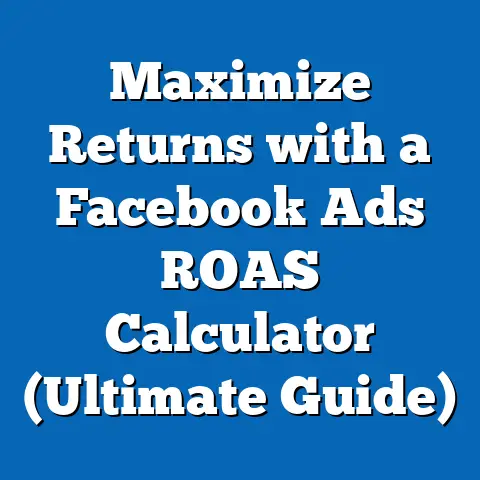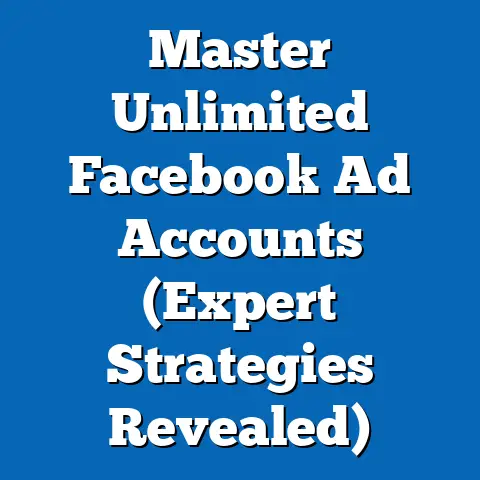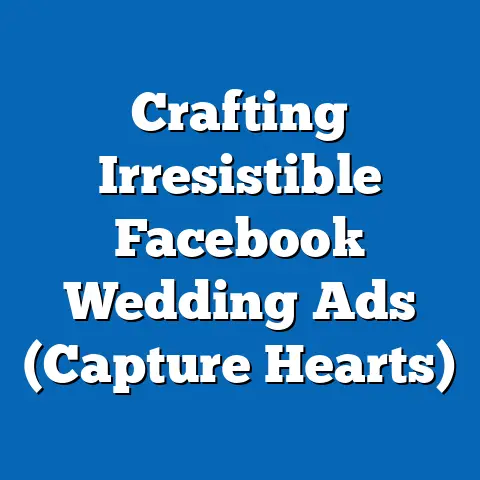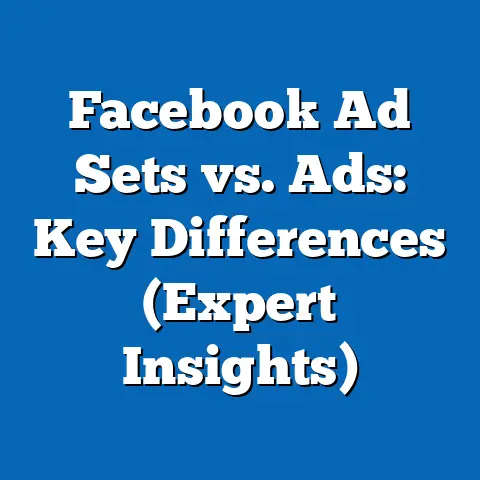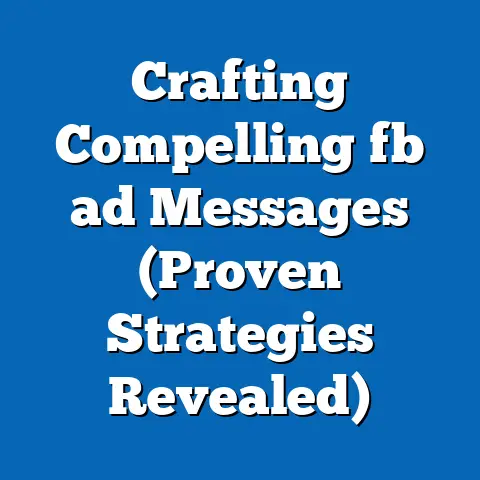Boost Facebook Ad Recall Lift (Proven Strategies Revealed)
Let’s dive into the world of luxury advertising on Facebook, where the goal isn’t just to be seen, but to be remembered. I’ve spent years studying what makes a brand stick in a customer’s mind, and in today’s digital age, Facebook is a key battleground. Luxury brands don’t just sell products; they sell experiences, aspirations, and a sense of belonging to an exclusive club. The power of a luxury brand lies in its ability to create a memorable experience that resonates with its audience long after they’ve seen an ad. In this highly competitive social media landscape, particularly on Facebook, effective ads can significantly enhance recall lift, allowing brands to stand out and make a lasting impression on potential consumers. This guide will explore proven strategies for luxury brands to boost their Facebook ad recall lift, ensuring they not only capture attention but also leave a lasting impression on their target audience.
Understanding Facebook Ad Recall Lift
Ad recall lift is the measurement of how much more likely people are to remember seeing your ad if they were shown it, compared to people who weren’t. In simpler terms, it’s about making your ads stick in people’s minds. It’s not just about impressions or clicks; it’s about creating a mental imprint.
For luxury brands, this is crucial. Think about it: a potential customer might not be ready to buy a $10,000 watch today. But when they are ready, you want your brand to be the first one that comes to mind.
The psychology behind this is fascinating. Luxury brands tap into our aspirational selves. They evoke emotions of desire, exclusivity, and success. When an ad effectively connects with these emotions, it’s far more likely to be remembered. It’s about triggering a feeling, a desire, a connection that goes beyond the product itself.
Key Metrics for Measuring Recall Lift
Several metrics help gauge the effectiveness of your recall lift efforts. Here’s what I look at:
- Ad Frequency: How often is the same person seeing your ad? Too little, and they might not remember it. Too much, and you risk annoying them. Finding the right balance is key.
- Engagement Rates: Are people liking, commenting, or sharing your ads? High engagement indicates that the ad is resonating with the audience.
- Brand Awareness Surveys: These are direct surveys asking people if they remember seeing your ads and what they remember about the brand.
- Search Volume: Are people searching for your brand or products after seeing your ads? An increase in search volume suggests that the ads are driving interest.
- Website Traffic: Monitoring traffic to your website post ad campaign can show direct impact.
Statistics and Studies: Studies consistently show a strong correlation between high recall lift and increased sales and customer loyalty for luxury brands. For instance, a study by Nielsen found that brands with high ad recall saw a 10% increase in purchase intent compared to those with low recall. This is significant because it directly translates to revenue.
Takeaway: Understanding ad recall lift is the first step. It’s about recognizing that your ads are not just about immediate sales, but about building long-term brand recognition and preference.
Crafting Luxury-Focused Ad Content
Luxury advertising is an art form. It’s not just about showing off expensive products; it’s about telling a story, creating an experience, and evoking emotions. I’ve learned that the best luxury ads are those that make you feel something.
The Power of Storytelling
Every luxury brand has a story to tell. It could be the history of the brand, the craftsmanship that goes into each product, or the lifestyle that the brand represents. Your ads should tell this story in a compelling way.
For example, a Swiss watchmaker might create an ad that showcases the meticulous process of assembling a watch, highlighting the tradition and expertise that goes into each timepiece. A high-end fashion brand might create an ad that tells the story of a designer’s inspiration, showcasing the artistry and creativity behind the collection.
Aesthetics and Visual Appeal
Luxury is all about aesthetics. Your ads need to be visually stunning, with high-quality images and videos. Pay attention to details like lighting, composition, and color grading. The visuals should reflect the brand’s identity and appeal to the target audience.
Think about the imagery often associated with luxury: sleek cars, elegant yachts, exotic destinations. These visuals evoke a sense of aspiration and exclusivity.
Emotional Appeal
Luxury is an emotional purchase. People buy luxury goods because they make them feel good. Your ads should tap into these emotions.
Consider the emotions that luxury brands often evoke:
- Desire: The desire to own something beautiful and exclusive.
- Exclusivity: The feeling of belonging to an elite group.
- Success: The sense of accomplishment and status.
- Aspiration: The hope of achieving a certain lifestyle.
Language and Messaging: The language you use in your ads is just as important as the visuals. Use exclusive terminology and aspirational messaging. Avoid clichés and generic phrases. Be specific and descriptive.
For example, instead of saying “high-quality leather,” say “exquisitely crafted Italian leather.” Instead of saying “luxury car,” say “the ultimate driving experience.”
Successful Examples: I’ve seen countless luxury brands nail this. Chanel’s perfume ads, for instance, often use cinematic storytelling and celebrity endorsements to create a sense of glamour and desire. Similarly, Rolex ads focus on the precision and craftsmanship of their watches, appealing to a sense of quality and tradition.
Takeaway: Creating luxury-focused ad content is about understanding the emotions and aspirations of your target audience. Tell a story, use stunning visuals, and speak their language.
Targeting and Audience Segmentation
You can have the most beautiful ad in the world, but if you’re showing it to the wrong people, it’s a waste of money. Precise targeting and audience segmentation are essential for enhancing ad recall, especially for luxury brands.
Leveraging Facebook’s Targeting Tools
Facebook offers a wide range of targeting options that allow you to reach affluent consumers. Here are some of the most effective:
- Custom Audiences: These are audiences that you create based on your existing customer data. You can upload a list of email addresses or phone numbers, and Facebook will match them to users on the platform. This is a great way to target your existing customers with exclusive offers or new product announcements.
- Lookalike Audiences: These are audiences that Facebook creates based on your existing customer data. Facebook will identify users who share similar characteristics and behaviors as your best customers. This is a great way to reach new potential customers who are likely to be interested in your brand.
- Interest-Based Targeting: Target users based on their interests, hobbies, and activities. For luxury brands, you might target users who are interested in fashion, travel, fine dining, or luxury cars.
- Demographic Targeting: Target users based on their age, gender, location, income, and education level. This is a good way to narrow down your audience and ensure that you’re reaching people who can afford your products.
- Behavioral Targeting: Target users based on their online behavior, such as their purchase history, website visits, and app usage. This is a great way to reach users who are actively shopping for luxury goods.
Tailoring Your Messaging
Once you’ve identified your target audience, you need to tailor your messaging to resonate with them. This means understanding their needs, desires, and pain points.
For example, if you’re targeting affluent millennials, you might focus on the sustainability and ethical sourcing of your products. If you’re targeting older, more established consumers, you might focus on the quality and craftsmanship of your products.
Case Studies: I’ve seen brands like Lexus successfully target high-income professionals with ads showcasing the comfort and technology of their vehicles. Similarly, high-end travel agencies use targeted ads to reach frequent travelers with personalized vacation packages.
Takeaway: Targeting is about understanding your audience and tailoring your message to resonate with them. Use Facebook’s targeting tools to reach the right people, and then speak their language.
Maximizing Engagement Through Interactive Ads
In a world of endless scrolling, you need to grab attention and hold it. Interactive ad formats on Facebook are a great way to do this. These formats not only capture attention but also foster deeper connections with your audience.
The Power of Interaction
Interactive ads encourage users to actively engage with your brand. This creates a more memorable experience and increases the likelihood that they’ll remember your ad.
Some popular interactive ad formats include:
- Polls: Ask users a question and let them vote on the answer. This is a great way to get feedback and generate discussion.
- Quizzes: Create a quiz that tests users’ knowledge of your brand or industry. This is a fun and engaging way to educate your audience.
- Augmented Reality (AR) Experiences: Allow users to virtually try on your products or explore your brand in a unique way. This is a great way to create an immersive experience.
- Instant Experiences (Canvas Ads): These are full-screen ads that load instantly and allow users to explore your brand in a rich and engaging way.
- Playable Ads: Allow users to play a mini-game or experience a product demo within the ad. This is a great way to showcase the features and benefits of your products.
Aligning with the Luxury Ethos
When using interactive ads, it’s important to align them with the luxury ethos. This means creating experiences that are sophisticated, elegant, and exclusive.
For example, a luxury fashion brand might create an AR experience that allows users to virtually try on their latest collection. A high-end car manufacturer might create an interactive ad that allows users to explore the interior and exterior of their cars.
Examples in Action: I’ve seen brands like Gucci use interactive polls to gather feedback on new designs, and brands like Dior create AR experiences allowing users to virtually try on makeup. These campaigns not only generate engagement but also reinforce the brand’s image of innovation and exclusivity.
Takeaway: Interactive ads are a powerful way to engage your audience and enhance recall lift. But it’s important to use them in a way that aligns with the luxury ethos.
Leveraging Retargeting Strategies
Retargeting is a powerful tool for reminding potential customers about your brand and products. It’s like a gentle nudge that keeps your brand top of mind.
The Reminder Effect
Retargeting ads are shown to users who have previously interacted with your brand, such as visiting your website, watching a video, or liking a post. These ads serve as reminders of your brand and products, increasing the likelihood that users will remember your ad.
Timing and Frequency
The timing and frequency of your retargeting ads are crucial. You don’t want to bombard users with ads, but you also don’t want them to forget about you.
I’ve found that a good rule of thumb is to show retargeting ads no more than 3-5 times per week. You should also vary the messaging and visuals of your ads to keep them fresh and engaging.
Avoiding Ad Fatigue
Ad fatigue is when users become tired of seeing the same ads over and over again. This can lead to them ignoring your ads or even disliking your brand.
To avoid ad fatigue, you should:
- Vary your ad creative: Use different images, videos, and copy.
- Segment your audience: Show different ads to different segments of your audience.
- Rotate your ads: Regularly update your ads to keep them fresh.
- Use frequency capping: Limit the number of times a user sees your ad.
Case Studies: Luxury travel companies often use retargeting to show potential customers the specific destinations they were browsing on the website. High-end furniture brands use retargeting to remind users of items they added to their cart but didn’t purchase.
Takeaway: Retargeting is a powerful tool for enhancing recall lift, but it’s important to use it strategically. Time your ads carefully, vary your creative, and avoid ad fatigue.
Conclusion
Boosting Facebook ad recall lift for luxury brands is a multifaceted approach that requires a deep understanding of consumer psychology, a keen eye for aesthetics, and a strategic use of Facebook’s advertising tools. By crafting compelling content, targeting the right audience, and leveraging interactive and retargeting strategies, luxury brands can not only enhance their visibility but also create lasting impressions that translate into customer loyalty and increased sales.
Remember, it’s not just about being seen; it’s about being remembered. In an ever-evolving digital landscape, prioritizing recall lift is essential for luxury brands to stay competitive and maintain their position as leaders in their respective industries. I encourage you to take these proven strategies and adapt them to your unique brand identity and target audience. The rewards of doing so will be well worth the effort.

